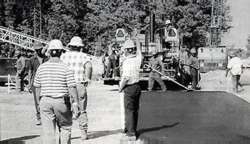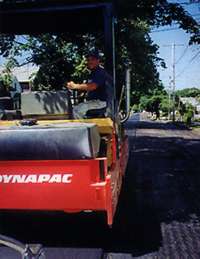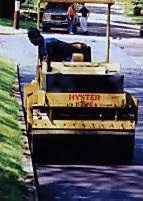
Cross train your crew By John S. Ball III
Peace of mind comes from knowing you have a well-trained roller operator at all times.
 It's a fine autumn day and your paving crew is gathering for the morning meeting by the paver. Off in the distance, you see the first asphalt truck appear on the horizon. But where's the roller operator? If he's out sick today, someone else gets the opportunity to run the roller. But who's qualified? You'd rather not teach someone bow to operate a 14-ton (12.7-Mg) vibratory roller on the expensive state highway project before you, so aren't you glad you spent some time training other members of the crew beforehand?
It's a fine autumn day and your paving crew is gathering for the morning meeting by the paver. Off in the distance, you see the first asphalt truck appear on the horizon. But where's the roller operator? If he's out sick today, someone else gets the opportunity to run the roller. But who's qualified? You'd rather not teach someone bow to operate a 14-ton (12.7-Mg) vibratory roller on the expensive state highway project before you, so aren't you glad you spent some time training other members of the crew beforehand?
Perfe ct timing
ct timing
If you're fortunate enough to have more than one roller operator trained and ready to perform, a day like the one above remains a fine autumn day. If you haven't taken the time to cross train your paving crew team members, you might be in trouble. If your roller operator doesn't make it to work, all of a sudden den you need to make the selection of who's going to run the roller.
The perfect time to teach someone to operate a roller is before you need them on the finished mat. Being able to practice, and make some mistakes, on a gravel or sandy lot, gives the trainee time to learn the mechanics of the machine. It gives the person time to build confidence in his or her ability to roll, which translates to a sense of pride in workmanship when it's time for the real thing.
 Take steps to train
Take steps to train
Gauge the desire
When you're ready to train someone to operate the roller, first determine if the person really wants to learn. As you communicate what's expected of this person in this role, gauge how committed he or she is to the task. Since the paving crew has to work together, as a group, you want true teamwork to get true quality in the finished product. The new roller operator has to have as much pride in the job he or she is doing as the other members of the team have in their roles. The candidate makes a commitment to the other team members when he or she accepts the job.
Start with the basics
If your new trainee has never been on a roller before, imagine his or her level of intimidation when climbing aboard an 84-inch (2-m) wide, 25,000-pound (1 1,340-kg) machine with 3,000 vibrations per minute capability. Instead, start this person on a static roller. That is probably the easiest roller to maneuver if you start with about an 8- to 10-ton (7.3 to 9-Mg) machine with a drum width between 50 and 54 inches (1.3 and 1.4 m).
Start the person out on a gravel parking lot or gravel road. This gives the person an opportunity to "try it out" in a forgiving area so he or she can make mistakes without fear of penalties.
 Get a feel for it
Get a feel for it
Let the operators get familiar with the machine. Let them start it and rev it up to operating speed, then go through the motions - forward, reverse, stopping, etc. Check the capacity of the water tanks so he or she can gauge when it will be time to stop and refill them. Since most rollers don't have water gauges, the new operator will need to keep track of how much water is being used so he'll know how long it takes to empty the tanks.
Help your trainee figure the number of passes it will take to finish a certain mat with the drum size you're working with. The number of passes needed forms the foundation of the rolling pattern. If the lane you're rolling is 12 feet (3.7 m) wide, the drum is 54 inches (1.4 m) wide and you're rolling with a 6-inch (150mm) overlap, it will take four passes to cover the whole lane.
 Design a pattern
Design a pattern
The heat of the mat will also determine your trainee's rolling pattern, so explain how far forward it's safe to roll without picking up asphalt on the roller. Teach him or her how to start a routine. Let him or her see the indentation the roller makes if you stop it on the mat. Let him or her see the tear it rips in the mat when you turn a stopped drum. Set up a rolling procedure where the operator is aimed down the mat with the drive drum in front.
Once this person is familiar with the machine, the thing we want to concentrate on is rolling patterns and rolling designs. Traditionally, we roll from the low side of the mat to the high side.
If you teach your new operator basic rolling patterns and explain rolling procedures, he or she will experience less confusion when the pattern has to change.
Keep up with production
Since the paving crew has to match production from the plant, the foreman of the team may have to speed up the paver at some point. The newly trained roller operator sees a paver that was just moving at 50 feet (15 in) per minute hop up to 70 feet (21 in) per minute. The roller is already working six times as fast as the paver to accommodate a back-and forth rolling pattern. All of a sudden, correct procedure goes out the window and enthusiasm goes with it.
You need to be consistent and methodical in how you're teaching this person. You've got to be truthful and sincere. Explain that it's okay to do shortcuts, but make sure he or she understands why you're doing a shortcut. There are right and wrong ways to do it.
Work as a team
Your veteran operator would like to keep his or her job so he's probably not going to show the younger person all the tricks of the trade. Getting someone to share job information out there is like pulling teeth, so make sure your trainee is paying attention. He or she will need to keep the ears and eyes open. Crew members are using different terminology and different applications that this person has never heard or seen before. If everyone is paying attention, they will learn from the other crew members through observation.
In the end, having several roller operators trained for duty can save a potentially disastrous sick day. With members of your team cross trained, you can interchange them when someone has to call in sick for the day. That's a nice luxury to have when that state highway project can't wait for one roller operator to get well
John S. Ball III is an industry consultant and principle in the firm Top Quality Paving, Manchester, N.H., which specializes in complete training programs.
Home | Articles | Qualification | Calculators
Top Quality Paving
PO Box 4398
Manchester, New Hampshire 03108
Cell Phone 603-493-1458
Write to us at our E-mail address for more information
tqpaving@yahoo.com
Visit Asphalt Contractor Magazine Online!
WebMaster: Sullivan+Wolf Design, LLC
 It's a fine autumn day and your paving crew is gathering for the morning meeting by the paver. Off in the distance, you see the first asphalt truck appear on the horizon. But where's the roller operator? If he's out sick today, someone else gets the opportunity to run the roller. But who's qualified? You'd rather not teach someone bow to operate a 14-ton (12.7-Mg) vibratory roller on the expensive state highway project before you, so aren't you glad you spent some time training other members of the crew beforehand?
It's a fine autumn day and your paving crew is gathering for the morning meeting by the paver. Off in the distance, you see the first asphalt truck appear on the horizon. But where's the roller operator? If he's out sick today, someone else gets the opportunity to run the roller. But who's qualified? You'd rather not teach someone bow to operate a 14-ton (12.7-Mg) vibratory roller on the expensive state highway project before you, so aren't you glad you spent some time training other members of the crew beforehand?
 ct timing
ct timing Take steps to train
Take steps to train Get a feel for it
Get a feel for it Design a pattern
Design a pattern